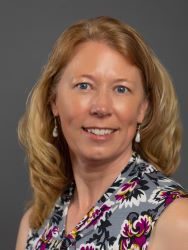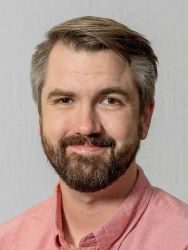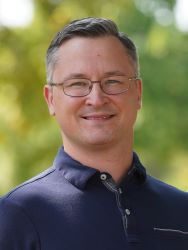Sarah Derouin for the American Chemical Society
To maintain excellence in chemistry education and train the chemists of tomorrow, the American Chemical Society asks the Committee on Professional Training (CPT) to create guidelines and standards for colleges and universities around the United States. To date, around 700 higher education institutions have ACS-approved chemistry programs.
CPT members represent a broad and diverse group of chemistry professionals. Members are picked to maintain a balanced representation of chemistry disciplines, gender and race, chemistry professions, and geography. CPT members come from industry, government, community colleges, and research universities.
New members join the committee every year and provide fresh perspectives to the group. Three associate members began their service in January 2023: Laura Anna, Matt Irwin, and Hubert Muchalski. They bring their chemistry expertise, commitment to ACS, and broad professional experiences to the approval program.
A History of ACS-support
Although they may be new to CPT, these three members are long-standing volunteers with various ACS committees and leadership positions. Laura Anna, organic chemist and Chemistry Department Chair at Montgomery College, has been active in ACS’s Division of Chemical Education (DivCHED) for years. She has been the co-chair of their Committee on Personnel and Nominations and is currently a Councilor for DivCHED.
“I feel myself being more and more drawn to the value of what ACS can do for individuals in their professions,” says Anna. That commitment has led her to join CPT. While at the Biennial Conference on Chemical Education, she was approached and asked if she would be interested in serving on CPT. “Apparently they were looking specifically for somebody representing two-year colleges to serve on the committee,” she explains, adding that she was excited and honored to be considered.
Matt Irwin, a formulation scientist at DuPont, has straddled work and research in the chemical engineering and material science fields since graduate school. His professional career, first at Axalta and now DuPont, has always included close collaborations between chemists and engineers. “I’ve always felt right in the middle between both chemical engineer and chemist,” he says.
Irwin’s first introduction to ACS came when the Philadelphia chapter had their Program Planning Committee work with chemists at Axalta to introduce them to the work at ACS and get them interested in the organization. “I started at the local level, just going to more events,” he says, adding that he gradually became more involved in national work. Eventually, he decided to run for the Philadelphia Chair-Elect position—he won. He also joined CPT, and says “I feel like the work on CPT has been very complimentary to my work at DuPont.”
Joining local ACS chapters often lead to bigger, national-level volunteerism. When Hubert Muchalski began his academic appointment at Fresno State in 2015, he was asked to join the local ACS section. “One thing led to another,” he says. “I was a treasurer for a couple of years and transitioned to Councilor.” As he started to learn more about the governance and structures of ACS, he decided to ramp up his work to the national level. CPT was one of the committees he was very interested in participating in.
“I thank my Ph.D. advisor for that,” he says. “He has high standards for chemistry education and training and he was on the CPT in the past.” Muchalski, an organic chemistry associate professor, agreed with his advisor’s perspective and says the goals of CPT aligned with his own personal philosophy. “It struck me that this committee— its mission— is to ensure standards of education and training of chemists for today and tomorrow.”
Diversity is the strength of CPT
The breadth of professions, expertise, and perspectives of CPT members is the strength of the committee. The group is comprised of people who genuinely care about the education of chemists and the success of academic programs. All three new members noted that they immediately saw the commitment and care from their fellow CPT colleagues.
“My first impression was it's a very balanced, very diverse group of people from all parts of the United States,” says Muchalski. He added that CPT has representatives from all levels of higher education, from small liberal arts colleges to big universities, who all work well together. It also gives the group perspective and strength.
“Chemistry is not taught the same way everywhere. Instructors work from small corners of their home departments, and it’s easy to have this impression, ‘Of course, everyone does it the same way,’” he says. “But each college course exists in a department, which is part of a larger unit, which has its own sets of rules and regulations.” He notes that CPT tries to maintain a standard for education, without trying to force rigidity.
Anna agrees, adding that from the initial meetings, it was clear that CPT was there to help and support programs and institutions to meet their goals. “I really appreciate that overall perspective in the committee,” she says.
The diverse perspectives in CPT lead to better results for all students, no matter what institution they start out in. “I like to say that our students become your students,” says Anna, who teaches at a two-year community college. She points out that no matter what school a student attends, the first couple years are going to look very similar. “We're all teaching the same classes, we sort of all have the same students just starting on different paths,” she notes, adding that students face the same sorts of challenges, no matter if they attend two- or four-year colleges.
Although two-year colleges have not approved by ACS, there are guidelines that parallel the four-year programs, says Anna. “One of the things that we're focusing on at the two-year college level is experiential learning and employable skills,” she says. “We can look at what ACS says are professional skills and standards for students and align them in our curriculum, so our students are better prepared for their next steps.”
Incorporating skills like safety is very important to chemistry graduates, and industry professionals like Irwin are glad that it is becoming more of an emphasis in university programs. “I'm encouraged by a lot of what we're doing in CPT,” he says. “[Safety] is a key [element] that we're evaluating, and part of our guidelines is considering what the safety program looks like and how safety is being taught.” Irwin notes that safety is always a big concern in industry.
Diversity, equity, inclusion, and respect (DEIR) efforts have become more prominent for a lot of major companies, notes Irwin. For example, Irwin says companies are focusing on structural efforts within the company that support Pride month celebrations or encourage discussions about pronouns. These are important parts of corporate culture, he says, adding that it is also crucial in creating and fostering inclusivity in chemistry departments. “In CPT it has been really exciting because with our new set of guidelines, we're explicitly calling out DEIR as an entire section of those guidelines,” he notes. “It's front and center.”
“We have a changing landscape of higher education,” says Muchalski. “We have different universities, different colleges, but then on top of that we have the cultural changes that happen in the country, and political winds that blow one way or the other.” He says that no matter what pressures some universities may feel, the mission of CPT is to accommodate and be supportive of all chemistry departments.
“I'm impressed by the productivity and engagement you have when you get a group of motivated volunteers together in the same room,” says Irwin. “The number of things that we can get through and the level of deep discussions we can have on really important topics for chemistry education— it's been phenomenal.”




